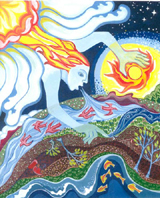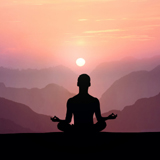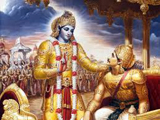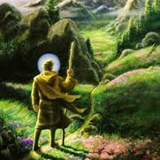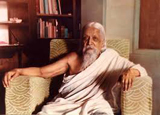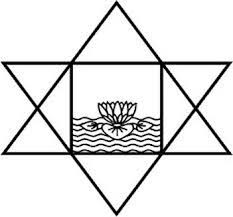Yogic insights into human psychology
Yoga and worldly life
Abstract
There is often an idea that spiritual life is antagonised to the worldly material life of man. This divide is at times seen merely as an extension of the opposition or so it seems between idealism and practicality. However this is only one side of the story. The other side is that, far from opposing each other the spiritual and the material are two aspects of one Existence and can fulfil rather than cancel each other This article tries to build the bridges between the two.
A perceived antagonism
There is a tendency to think that people who take to spiritual life become somehow weakened and incapacitated for dealing with real life issues. Nothing can be farther from the truth. This misperception is based on a wrong understanding of true spirituality as well as a wrong understanding of life. The spiritual history of mankind is replete with instances of spiritual men and women who excelled and had gained high attainments in whatever field of work they chose. There have been writers like Vyasa and Valmiki, Homer, Dante, Kalidasa and many others right upto Sri Aurobindo in modern times, who have produced some of the finest literature of various kinds that have remained unparalleled in their beauty and significance. I am not even counting the works of the ṛsis of the Vedas and Upanishads which are rich in poetry of the most sublime kind.
But literature is not the only field of action of spiritual men and women. Social reformers such as Ram Mohan Roy, Swami Vivekananda and the mighty Buddha were all deeply spiritual. There have been kings who have ruled their kingdom with such beauty and grace that their exploits have remained ingrained in the memory of the race. There have been warriors and heroes who were deeply spiritual, Then a whole host of other activities such as painting, sculpture, dance, science and technology, medicine, linguistics and many others have been taken to great heights by spiritual human beings. Even what is regarded as something mundane and ordinary as marriage and childbirth has been taken to quite another level by spiritual people. Love itself has been uplifted to levels beyond our imagination and life has often felt the thrill of a diviner touch and filled with a diviner breath, when it has entered the frame of a spiritual being. One could go on multiplying examples with no end. This is not only in India but all over the world.
The difference however has been that in the Western world, ever since spiritual impulsion got divorced from life and became confined to monasteries with the masses being content with religious belief-systems, the impact of spiritual life has remained little known. Those who were truly spiritual did not advertise their spirituality and since they had pursued it independent of the religion they were born in, their spiritual side did not receive much support from the organised religious institutions. In fact if facts were to speak for themselves then, the great days when intense creative impulsion moved India were also those times when the spiritual impulsion was at its peak.
But the misperception is there that spirituality is other-worldly and hence has little role in our everyday life. The spiritual man must abandon normal ordinary life to pursue his spiritual quest. This misunderstanding is largely due to identifying one kind of spirituality as the only one. Most people regard spiritual life as asceticism and think of a spiritual man as someone who wears a certain kind of robe, who has no house or bank balance and who wanders from place to place begging for alms for sustenance, since he has lost all interest in his self-preservation, reducing it to a bare minimum. Even when one admits some kind of a meeting-ground between spirituality and life, one identifies spiritual life with learning and practising some form of meditation techniques which calm us and give us peace, which fills us with tolerance and take away the drive of ambition and desire and hence it is concluded that these people become unfit for life, which needs those aggressive instincts to survive and achieve. Besides with the great Nirvana as the goal, whatever normal operations of life we may be engaged in are regardedonly as some kind of concession to the fact that we are embodied beings and hence need to continue our outside life as before, under the stress of the past momentum of nature, while inwardly we are losing interest in it and preparing ourselves for some kind of a final exit. Then there is also this conception that at the root of things is Nothingness which makes a mockery of ‘everything’.
Life denying and life-affirming spirituality
We usually identify spirituality with the denial of life, but there is also a world-affirming spirituality as given to man by Sri Krishna and Sri Aurobindo. Besides, denial is also sometimes a step towards a greater affirmation. Spiritual life may find life as it stands today very inadequate and imperfect and hence it may go far away from it in search of a more perfect existence. But having found this, it may return to life as it stands today and pour its riches upon the world to try and make life perfect with the Divine Perfection. There is in fact, another line of spiritual living that is not only compatible with worldly life but strengthens it with a new impulsion. This is typified in the great teachings of the Upaniṣads and the Gita, in the luminous writings of Swami Vivekananda and Sri Aurobindo, writings that can set our soul ablaze with the fire of spiritual truths alive. But even if we set aside these great teachings for a moment since we feel ourselves weak and ill-equipped to handle them, then also things such as peace and equanimity that develop naturally through spiritual practices or love and compassion and tolerance, give us an edge even for our ordinary life.
No wonder they are often referred to as soft powers. It is a mistake to underestimate these powers. Even the humblest of them such as humility and gratitude have the capacity to straighten out longstanding misunderstandings. For those who value harmony and the joy of relationship with the world and its countless creatures that co-inhabit it, it is a small gain to discover the secret of a happy and harmonious co-existence. Then there is something so soft and subtle as beauty, a power that has been much distorted by equating it with surface appearances. But Beauty when we look deep enough into its soul is the sister of joy and the secret flaming core of love. It is because we have shunned beauty or regarded it only as something superficial that there has been such a downfall, in India at least. We stopped valuing beauty and we can see the result in every sphere whether it be vulgarity of speech and sensations or vulgarity in thoughts and actions, vulgarity in outer and inner life, in music and technology and everything else.
Beauty is not just about the beauty of form. There is a formless essence of beauty, a mystic truth that may or may not reside in a form that we need to discover. After all, at the end of it do we not want life to be beautiful? How are we to do it if we shun this soft power which at its core is spiritual. Then there is the power that is the very base of everything else. It is that much coveted and least found Peace. The world suffers because of want of Peace. Without Peace nothing enduring can be built, nothing lasting can be erected. Peace is the very foundation of all things. There is another quality which though not a soft power is yet an extension of Peace. It is Equanimity.
Yogic texts lay a great emphasis on equanimity. Yet it is one of the least understood and least practised of qualities. Yet this one quality can help us not only withstand all the assaults and challenges of life but put us in the right condition to understand things in a better way and to give us the right response to them. When our mind and emotions are disturbed and restless, then our perception about people and events and circumstances are clouded and our reactions to them naturally confused. How often has it not happened that in a given situation we responded in a certain way which we repented much later, realising the stupidity of our reactions.
But why did it happen and why do we understand it better as time rolls by? The thing is that with passage of time the dust and smoke and the storm and clouds settle down and we can see things clearly. The initial perception and reaction were coloured as it were by our own restless emotions, blinded by storms of anger and passion, darkened by mistrust and all the rest that distorts our understanding of things and thereby opens the doors to every kind of confusion. The result is so much avoidable suffering. This is not only in the psychological field but also the physical. The effect of anger and fear and restlessness and anxiety on our body is rather well known. Peace and equanimity are like the calming agents that create the right conditions for us to perceive things better and to make the right and true responses to events and people and circumstances. A wide equanimity and a cultivation of peace should be considered as the very basis of a happy and healthy life.
The springs of spiritual action
One may say that all this is very fine. All these qualities, though acquired more easily through yoga, may be helpful to make us a good human being, even perhaps a creative human being but what about meeting the challenge of life, what about the survival of the fittest, what about the competition and strife that abound in our everyday life? It is true that competition and the blind race that drives humanity towards the abyss does not go with yoga. Nor does anger and aggressiveness and ambition thrive long in an individual who strives rightly for yoga. But as these things which are the stuff of what we are ordinarily made drop of, other things take their place which hold us in even better stead even from the point of view of worldly success.
Take ambition for example. It is true that ordinarily, man is impelled by the goad of desire and the whiplash of ambition. This dark deity nevertheless drives us to perform and thereby becomes the motivating force for a kind of progress in mankind. But this progress comes at a heavy cost. It is like the old coal engines that drove the train but threw up much smoke in the process. It had a limited ability to pull the carriages but in the absence of better fuel this was the cheapest method to take us from one station to another. But as we progressed scientifically so to say, better and more efficient fuels were discovered. Something similar applies to the field of all human activities.
Desire is a fuel but not the best one. Hidden behind desire and clouded by it there is will and faith. These are the original driving engines for man. But since we have not developed them, in fact everything that we learn in school, helps to deactivate these inbuilt original driving- systems installed within us. It is the virus of artificially defined success that has corrupted these engines. It is not our true nature but a distortion introduced by the mind. True success is to live the truth of our life. And we are given all the tools needed to express it. When we do that, we discover joy and our life discovers its true harmonious rhythm leading to a sense of satisfaction and even fulfilment. This state is most conducive to psychological, social and physical well-being. If instead of competing with others, each one tries one’s utmost to discover and live the truth of one’s own being then each would automatically give one’s best. In other words, we define success artificially like the rabbit and tortoise fable and then go about running a mock race. Spiritual perception clears this basic wrong understanding and thereby helps us put our efforts in the right direction.
Implicit behind this is the recognition that there is a Wisdom that works in creation and to each it has allocated a role and a place. Life is the way to find this place. Action is a means to discover what is our role in this universe, a role that is uniquely ours and which none else can occupy. When we live life with this perception. then we simply do what we are meant to do just as the winds blow, rivers flow, as the sun radiates heat and light, and flowers offer their fragrance. It is simple, easy, natural. Then we are freed from stress and ambition but in fact succeed in the true sense, since we are what we were meant to be. It is only when we try to measure our success in relative terms by comparing it with others’ that we are constantly under stress and even when we ‘succeed’ we are not happy. A constant unhappiness gnaws in our hearts and makes all our success seem hollow. The result is chronic unhappiness which we try to cover up with artificial and scentless flowers that look real but are not. Or else we run here and there in search of an illusory happiness, get high on wealth and position, or take to alcohol, drugs and other forms of pleasure to help us momentarily forget the pain and the sadness behind our smiles.
But there is still more. Spirituality in fact makes us strong in more ways than one. The Upaniṣads say that this self is not for the weak and indeed it is so. Spirituality takes away from us all fear and anxiety and replaces it with faith and trust. It makes us fearless, so to speak. It prevents the huge loss of energy that we incur through these leaking holes that sap our energies. It also frees us from anger which is in fact the sign of a weakness. Instead it fills us with the courage and confidence that are so much needed for success in any sphere of life.
Finally, by a sustained practice of concentration, we gradually develop the skills of a perfect marksman who directs his aim straight at the target. After all, true success is not the handmaid of aggression but of concentration. Aggression may help temporarily achieve success in some fields such as sports because through it one accumulates all the energies necessary to achieve one’s target. But for all its merits, aggression is a poor fuel. It may give an immediate kick-start but damages the system in the long run. Its harmful effects upon our social life and relationships are well known.
What alternative fuel in driving human nature does yoga provide? We have a few choices here. Yoga teaches us that work is worship and hence the yogin pursues excellence for the sake of it. He is neither working for any earthly reward nor to secure any other-worldly seat in heaven. For him work is a means to worship the Divine and hence he does it with utmost care. Besides a state of inner peace helps the yogin focus better. Work flows through a yogin naturally as a river flows towards the ocean. The Gita declares, ‘Yoga is skill in works’, and it is indeed so in the experience of yogins. Part of the misconception arises because we associate peace with inertia, but peace is a very powerful state. It clears the human system of all kinds of rough and turbulent energies and thereby helps the free and smooth flow of energies through us. This is the second fuel.
Yoga opens us to doors of infinite energy from above and not as we presently draw from food and interchanges with people and the environment. Most of us represent a small container shrunk by the ego-self. But a yogin experiences a widening of his consciousness and thereby opens to a much greater influx of energies from all around. Thirdly, the work of a yogin does not stem from desire but from something much more powerful and that is love. Whatever a yogin does, he quite naturally puts his heart and soul into it, literally so. Finally, by subordinating his individual personal will to something higher and vaster, the divine Will, he quite naturally opens to the divine Śakti itself that is working in creation from behind the veils of nature. As a result of all this, a yogin has a free and easy access to delight and hence he does not try to amass wealth or other poor and dark substitutes for happiness since he has an abundance of it at his disposal. But this Delight is a creative force and it pours through the yogin in countless works. Not only is the quantum of work much more but the yield is of a very good andsuperior quality, since he is now one with every original impulsion of creation. His creativity therefore touches peak in whatever sphere it is turned towards.
The perfect remedy for stress and suffering
We can therefore easily see how a sustained practice of yoga can make our individual and collective life much better, lifting it towards some high ideal of a diviner living. Even at a much lesser pitch, it takes away the stress and strain that we constantly experience and thereby improves remarkably the quality of our life. The role of yogic practices and yogic approach in reducing stress is already well known. But most often, it ends up with an almost exclusive emphasis on certain techniques such as meditation and prāṇāyāma. Useful as they are no doubt — and it is now too well known to be elaborated — there are other processes, internal psychological processes so to speak, which help us immensely to get rid of the stresses and strains in our everyday life. As noted above, the practice of niṣkāmakarma (action undertaken without an eye on the fruit) is a wonderful antidote to the stresses we feel which are due to undue expectations and anxieties about the future. Many people think that one acts only for the fruits and if this was not thought of, then the very basis of action is gone.
This is not true. Some of the greatest and mightiest actions documented in history have been not acts done with calculation about the fruits of efforts but acts of spontaneous sacrifice for an Idea one believes in, or acts of valour for the sake of honour even though one knows it is inviting imminent death, or higher still, acts of love for which even wars have been fought and won against terrible odds. The aggressive man who wants to dominate the world and strides across the continents as a gigantic shadow is an Asura and not a true Kṣatriya. A true warrior-type, whether in India as the Kṣatriya or Samurai or Knights have acted for valour and honour rather than for any outer results.
What about those who cannot rise upto this high and noble ideal? It is precisely for them that the spiritual teaching is relevant. See the Gita for example. It teaches us the utter unreality of death, it teaches us to remain equal in victory and defeat, in gain and loss but then it also teaches us to fight the great battle of life with love and courage in our hearts, with all the skill at our disposal. Even a little practice of this can free the tremendous potential for right and true action in man, making his own life and the life of humanity so much better. Secondly, by learning to live in tune with the truth of our being we feel the natural Delight as all do when they follow their innate impulsion. It is only when we deviate from our inner truth and follow an alien way, alien to us while it may be perfectly natural to another, that we feel stifled and depressed. This is so because one of the intrinsic causes of chronic unhappiness is that we are no longer leading the life intended for us. This has been one of the great civilisational losses that with the rise of competitive consumerism, individuals have become like consumer products with a price-tag attached to them, efficient as a machine, serviceable and perfect and artificial and robotic and false.
All this falsehood yoga tends to remove like a washing-powder removes the stains from a cloth and lets its true colour shine through. There is another reason why yoga helps us keep away all stress and depression. First of all, it opens the doors of knowledge, true knowledge for us so that we become aware of the truth of our own self and the truth of the world around us. This truth and knowledge are liberating. Truth frees us from the small and narrow moulds into which we cabin our life and suffer. True Knowledge, born out of spiritual seeking, frees us from all narrowness and smallness and makes our being enter a vastness that we had never known before. We are liberated from all isms and prisms, constructs of thoughts, ideas and opinions and one-sided viewpoints. It frees us from all the narrowness in which belief systems are caught. This freedom, this vastness, automatically opens us to the Delight that constitutes the very fabric of creation. But because the mind and ego and desire shut us into smallness, narrowness and pettiness, we lose contact with this Delight which is the origin, the secret support and the goal of creation. This Delight pervades all things but in the small consciousness it changes into pleasure, pain and indifference. But since there is within us always this constant pull towards the Delight, which runs as a sap through the core of all things, we are never satisfied with anything. All our pleasures and joys are temporary illusions which are so many steps to keep us tied to the great journey of life. The breaking of each illusion gives us pain, we are pushed out of our comfort-zones and experience pain. Yet this pain is our means to step out of an illusory reality and discover the true truth of our being. This discovery brings us natural Delight.
In conclusion
Well, these are some of the ways that yoga can make life not only beautiful but also strong. But this is only the minimum. The reach of yoga goes much further than the emergence of latent possibilities and capacities of knowledge and will, to the fullness of life leading to wholeness and integration with the creation and the Creator Himself. Are these things of less value than amassing and possessing and hoarding and lusting after things outside while stress, anxiety, depression and fear eat up our very body and soul from within? After all, at some point, we need to think about the very purpose of our existence, the goal of our life, the larger picture behind the little scene of our earthly drama. Of course, we still have a choice and one thing that yoga does not do is to take away our fundamental freedom to evolve in our own way, at our own pace and in our own time. It is this, among other things, that makes it a thing apart from cult and sect and religion. It shows us a path, gives us a broad map, marks the main signposts, teaches us what may help or hinder us on the way but in the end leaves us free to explore and undertake the tremendous journey of life, which itself is a secret yoga of nature, in our own way.
In the end, we discover that spiritual life and material life are not like two parallel lines that never meet, but rather that they are like two streams of life that run one below the other, the inner supporting the outer. Most often we live on the surface stream, remaining entirely oblivious of the deeper inner stream whose pure and crystalline waters rejuvenate us almost instantly. From time to time, especially during moments of crisis, this inner stream tends to come to the surface to help us sail through the most difficult times. Some catch this inner thread when this happens and enter the fast track of evolution. Others fail to notice or catch it or, having caught hold of it, momentarily lose it and fall back upon the old, painful and laborious processes of nature through which she accomplishes her great work of evolution. What she intends to accomplish through this long and laborious process is to help the divine possibility inherent in all things to emerge over long spaces of time. Yoga does the same thing in a much faster, quicker and safer way. It is this view of yoga and life that reconciles the two seeming opposites. Life and yoga are not two but one thing. Life, at least as we experience it, is a concealed yoga. Yoga as the yogin experiences it, is life taken to its utmost pitch of possibilities.
Sri Aurobindo reveals this to us beautifully:
“In the right view both of life and of Yoga all life is either consciously or subconsciously a Yoga. For we mean by this term a methodised effort towards self-perfection by the expression of the secret potentialities latent in the being and — highest condition of victory in that effort — a union of the human individual with the universal and transcendent Existence we see partially expressed in man and in the Cosmos. But all life, when we look behind its appearances, is a vast Yoga of Nature who attempts in the conscious and the subconscious to realise her perfection in an ever-increasing expression of her yet unrealised potentialities and to unite herself with her own divine reality. In man, her thinker, she for the first time upon this Earth devises self-conscious means and willed arrangements of activity by which this great purpose may be more swiftly and puissantly attained. Yoga, as Swami Vivekananda has said, may be regarded as a means of compressing one’s evolution into a single life or a few years or even a few months of bodily existence. A given system of Yoga, then, can be no more than a selection or a compression, into narrower but more energetic forms of intensity, of the general methods which are already being used loosely, largely, in a leisurely movement, with a profuser, apparent waste of material and energy but with a more complete combination by the great Mother in her vast upward labour. It is this view of Yoga that can alone form the basis for a sound and rational synthesis of Yogic methods. For then Yoga ceases to appear something mystic and abnormal which has no relation to the ordinary processes of the World-Energy or the purpose she keeps in viewin her two great movements of subjective and objective self-fulfilment; it reveals itself rather as an intense and exceptional use of powers that she has already manifested or is progressively organising in her less exalted but more general operations…(1)
“The true and full object and utility of Yoga can only be accomplished when the conscious Yoga in man becomes, like the subconscious Yoga in Nature, outwardly conterminous with life itself and we can once more, looking out both on the path and the achievement, say in a more perfect and luminous sense: ‘All life is Yoga.’…(2)
“It is possible for the spiritual life in the world, and it is its real mission, to change the material life into its own image, the image of the Divine. Therefore, besides the great solitaries who have sought and attained their self-liberation, we have the great spiritual teachers who have also liberated others and, supreme of all, the great dynamic souls who, feeling themselves stronger in the might of the Spirit than all the forces of the material life banded together, have thrown themselves upon the world, grappled with it in a loving wrestle and striven to compel its consent to its own transfiguration. Ordinarily, the effort is concentrated on a mental and moral change in humanity, but it may extend itself also to the alteration of the forms of our life and its institutions so that they too may be a better mould for the inpourings of the Spirit. These attempts have been the supreme landmarks in the progressive development of human ideals and the divine preparation of the race. Every one of them, whatever its outward results, has left Earth more capable of Heaven and quickened in its tardy movements the evolutionary Yoga of Nature... (3)
“The spiritual life does not need, for its purity, to destroy interest in all things except the Inexpressible or to cut at the roots of the Sciences, the Arts and Life. It may well be one of the effects of an integral spiritual knowledge and activity to lift them out of their limitations, substitute for our mind’s ignorant, limited, tepid or trepidant pleasure in them a free, intense and uplifting urge of delight and supply a new source of creative spiritual power and illumination by which they can be carried more swiftly and profoundly towards their absolute light in knowledge and their yet undreamed possibilities and most dynamic energy of content and form and practice. The one thing needful must be pursued first and always; but all things else come with it as its outcome and have not so much to be added to us as recovered and reshaped in its self-light and as portions of its self-expressive force... (4)
For the sadhaka of an integral Yoga none of these reasons are valid. With weakness and selfishness, however spiritual in their guise or trend, he can have no dealings; a divine strength and courage and a divine compassion and helpfulness are the very stuff of that which he would be, they are that very nature of the Divine which he would take upon himself as a robe of spiritual light and beauty. The revolvings of the great wheel bring to him no sense of terror or giddiness; he rises above it in his soul and knows from above their divine law and their divine purpose. The difficulty of harmonising the divine life with human living, of being in God and yet living in man is the very difficulty that he is set here to solve and not to shun. He has learned that the joy, the peace and the deliverance are an imperfect crown and no real possession if they do not form a state secure in itself, inalienable to the soul, not dependent on aloofness and inaction but firm in the storm and the race and the battle, unsullied whether by the joy of the world or by its suffering. The ecstasy of the divine embrace will not abandon him because he obeys the impulse of divine love for God in humanity; or if it seems to draw back from him for a while, he knows by experience that it is to try and test him still farther so that some imperfection in his own way of meeting it may fall away from him. Personal salvation he does not seek except as a necessity for the human fulfilment and because he who is himself in bonds cannot easily free others, — though to God nothing is impossible; for a heaven of personal joys he has no hankerings even as a hell of personal sufferings has for him no terrors. If there is an opposition between the spiritual life and that of the world, it is that gulf which he is here to bridge, that opposition which he is here to change into a harmony. If the world is ruled by the flesh and the devil, all the more reason that the children of Immortality should be here to conquer it for God and the Spirit. If life is an insanity, then there are so many million souls to whom there must be brought the light of divine reason; if a dream, yet is it real within itself to so many dreamers who must be brought either to dream nobler dreams or to awaken; or if a lie, then the truth has to be given to the deluded. Nor, if it be said that only by the luminous example of escape from the world can we help the world, shall we accept that dogma, since the contrary example of great Avataras is there to show that not only by rejecting the life of the world as it is can we help, but also and more by accepting and uplifting it. And if it is a play of the All-Existence, then we may well consent to play out our part in it with grace and courage, well take delight in the game along with our divine Playmate (5).”
References
1. Sri Aurobindo. Birth Centenary Library, Volume 20. Pondicherry: Sri Aurobindo Ashram Trust; 1970, p. 2.
2. Ibid., p. 4.
3. Ibid., p.22.
4. Ibid., pp. 134-35.
5. Ibid., pp. 312-13.Dr. Alok Pandey, an editor of NAMAH and a member of SAIIIHR, is a doctor practising at the Sri Aurobindo Ashram.
Share with us (Comments,contributions,opinions)
When reproducing this feature, please credit NAMAH,and give the byline. Please send us cuttings.






